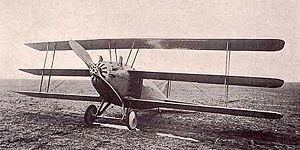Top speed 262 km/h Length 7.11 m | Wingspan 9.75 m First flight May 7, 1918 | |
 | ||
Manufacturer Curtiss Aeroplane and Motor Company | ||
The Curtiss 18T, unofficially known as the Wasp and by the United States Navy as the Kirkham, was an early American triplane fighter aircraft designed by Curtiss Engineering for the US Navy.
Contents
Design and development
The Curtiss 18T was intended to protect bombing squads along the French coast, and a primary requisite for this job was speed. Speed was not the triplane's only salient feature: an 18T-2 set a new altitude record in 1919 of 34,910 ft (10,640 m). The streamlined and very "clean" fuselage contributed to the aircraft's performance. The basic construction was based on cross-laminated strips of wood veneer formed on a mold and attached to the inner structure. The technique was a refinement of that used on the big Curtiss flying boats.
Operational history
Flown by Roland Rholfs, the 18T achieved a world speed record of 163 mph (262 km/h) in August 1918 carrying a full military load of 1,076 lb (488 kg).
The Model 18T-2 was an improved version of its predecessor, boosting 50 additional horsepower. The wings of the new model were swept back. It was also 5 ft (150 cm) longer with a 9 ft (270 cm) longer two-bay wing, though its flight ceiling was 2,000 ft (610 m) lower.
After World War I, it was employed as a racing plane: an 18T-2 nearly won the Curtiss Marine Trophy Race in 1922 (limited to U.S. Navy pilots), but pilot Sandy Sanderson ran out of fuel just before the finish line.
Curtiss Engineering followed the success of the Model 18T with the launch of the Model 18B, unofficially known as the "Hornet", built to otherwise similar specifications.
Variants
Operators
Specifications (T-1)
Data from Curtiss Aircraft 1907–1947
General characteristics
Performance
Armament
